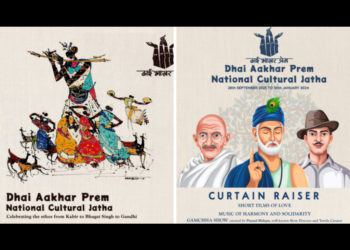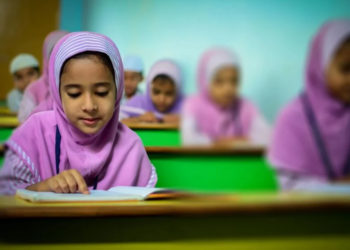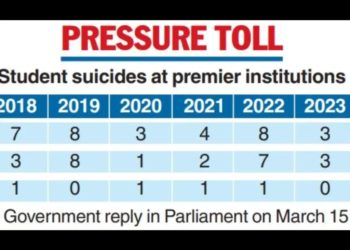Nearly ten thousand people had assembled at historic Deekshabhumi in Nagpur on December 25th, 2016 to embrace Buddhism as envisaged by Babasaheb Ambedkar nearly 60 years ago at the same place along with nearly half a million people on Ashoka Vijayadashmi day in 1956, but this time the Deeksha was being led by Bhadant Nagarjun Surai Sasai, who originally hails from Japan and made India his home long back in 1960s and this time the people who embraced Buddhism were mostly from various OBC communities. The chanting of ‘Buddham Sharanam Gachchami’’ reverberated in the air. In an impressive Marathi, the octogenarian monk ask people to follow him word by word as he start narrating the 22 oaths that Babasaheb Ambedkar had used to get the people ‘dhamma deeksha’on October 14th, 1956. Such is his influence that people listen to him, follow him and look upon for guidance. Bhadant Nagarjun Surai Sasai has made India his home and a place to fulfill his mission to make India a Prabuddha Bharat, as dreamt by Babasaheb Ambedkar.
As I go to meet him at his Indora Buddha Vihar in Nagpur that he built as he made the city his workplace to fulfil the dreams of Babasaheb Ambedkar. I ask him, “When did you come to India and how did you get involved in the Ambedkarite movement?”. “I came in 1967 exactly 11 years after the Mahaparinivwan of Dr Babasaheb Ambedkar. Babasaheb got Mahaparinirwan in 1956. And he proudly says this to me. Though he became Buddhist in Japan only, India always inspired him. He says, ‘It was my wish to come here. In Japan there was not much known about Babasaheb. I felt even the governments were not interested to tell the world about Babasaheb. The Japanese Sangh sent me to Thailand first. I stayed in Thailand for three years. Then I had to return to Japan but I informed the Japanese Sangh that I would not return to Japan but would visit India and have darshan of Lumbini, Bodhgaya, Sarnath and other sacred places’.
And he landed up in Rajgiri which he always referred as Rajgrih in 1966. He says, ‘I went to Rajgir first. This is the place where Buddha came here as promised to king Bimbisara. There I went to a, Nichidatsu Fujji, a Japanese monk. He was planning a ‘peace pagoda’ or Shanti Stupa at the pragbodhi Hill of Rajgir. First I came to Kolkata and then came to Rajgir. There are 13 sects in Japan which follow Buddhism. I was different from Fujji. But despite that, I felt that he too was Japanese hence I decided to engage in the Shramdan. This kept me in Rajgir to build the Shanti Stupa. There were not many Japanese people hence we had to take help from the local people in digging. I used to not only look after but also do the digging work. Many times, I saw tigers there. After some time they handed the work to a construction company hence my work was done and naturally the devotees were coming who belonged to different sects and there were chances of disputes and differences hence I thought to return to Japan.’
Despite those difficult circumstances Bhadant Surai Sasai lived there for over one and a half year and told me that, ‘ I was thinking of returning to Japan. It was the Purnima in the month of August. It was total rainy season. To be precise, it was August 8th and midnight. I was in my dhayana when someone pats me on the back. I opened my eyes to see a figure with white hair and long whitish moustache. It was Purnima and hello around him was shining. I was frightened for a while as I never had such an experience. I asked in my heart as I did not have the courage to speak up openly, who you are. Who are you? My voice was not coming out. I started chanting the Buddhist Mantra. Then the voice came in my ear. ‘I am Nagarjuna. You go to Nagpur immediately. Nagpur is my karmbhumi and Janmbhumi as well as Nirwanbhumi too. You go to Nagpur and it will become your Karmbhumi too’, He said. I was just listening and chanting. After some time He disappeared. Then I asked Fujji Guruji as where is Nagpur. He said, I don’t know. He had been staying in India for over 30 years yet did not know Nagpur. He asked me what happened. I informed him about the incident. He said you must have it in your dream. I said no. He appeared before me. He said it is in Central India. I said, I will not go to Japan but go to Nagpur instead. I was ordered by Venerable Nagarjuna to go to Nagpur and yes it was not a dream as he gave me live darshan so I had to follow his orders. I had my return ticket for Japan via Thailand but I cancelled them. I decided to go to Nagpur. I did not have any knowledge of Hindi that time. I had only just working knowledge of Hindi, not much. I did not know things about India. Finally, I arrived in Nagpur. Did not know how to go so came via Patna. Boarded a train and got down at Allahabad and started looking for general coach in the train towards Andhra-Chennai. It was slightly raining. I did not know how long and how far it was but by asking people finally I got down in Nagpur. I did not have any knowledge, any acquaint about Nagpur that time so I came out of the station and sat in front of it, started my chanting of Buddhist mantras. Slowly, people started coming in. I asked people if there was any Buddha Vihara. People asked him where have, I come from as I did not tell anything. There was tension on the Indo-China border so many people felt I might be from China and do something wrong as I did not tell I am from Japan. Some of them started asking me to be sending away from there. I said, I am a Buddhist monk who came here 10 years later Babasaheb took Dhammdeeksha, even Anand Kauslayan came after me. I asked, don’t you know any Bhante here. So, one rikshawallah took me to a Buddha Vihar built by Waman Godbole who took an important role during the Dharmantaran ceremony of Babasaheb Ambedkar. As I entered his house, there were huge portraits of Buddha as well as Babasaheb Ambedkar in his tie suit. I asked who is this man? Godbole said, Bhante ji, don’t you know him. Haven’t you heard name of Dr Ambedkar. I said, no. He said, Ambedkar is a great man who made many people Buddhists in India. I was just thinking that Buddhism did not exist in India. Then, I asked Godbole , are you a Buddhists, he said yes. All the friends there said they were Buddhists. I was gladdened to hear so many voices claiming Buddhists. Then, I told them that I have come from Japan. I then stayed at the House of Godbole for nearly a month. Then he took me to another place and I got a place to live.’
Waman Rao Godbole has been a highly respected Ambedkarite in Nagpur who supported Bhadant Nagarjun Surai Sasai who was willing to learn local languages everywhere he travelled and that too not by formal education but by way of conversation. ‘’ I did not learn Hindi. I learnt it by speaking with people. There was no formal education of Hindi for me. I was send to Thailand and from Thailand where did I go? India. I got a letter that fine you are in India but I was told not to learn Hindi. I was surprised. Why? I thought people go to Japan and learn Japanese, go to Thailand and speak Thai then why shouldn’t I learn Hindi to understand India. He said since there are Buddhists in India so that I should not learn Hindi. I was shocked as why should not I learn Hindi as there were Buddhists in India and Hindi is essentially linked to Hinduism according to them hence I should not learn Hindi. I discarded their advice and continue to interact with people and learnt Hindi. I still can’t write Hindi that well but can speak easily. I have been here over 50 years interacting people hence now I can make a speech in the public in Hindi as well as in Marathi. Two days back, I got people swear 22 vows of Babasaheb Ambedkar for OBC Dhammadeeksha. I got them in Marathi and people were very happy. They complimented me.
He was visibly pleased that over ten thousand OBCs took Deeksha under him on December 25th, 2016 at Deekshabhumi Nagpur. He says, ‘Babasaheb used to say, I would make India, Buddhist. The Constitution of India is based on Buddhist principles. Babasaheb himself said our constitutional revolution is not influenced by French revolution but by the principles of Buddha. The chakra and three colours in our national flag are based on Buddhist ideals. Every religious person whether Muslim, Christians, Hindu, Sikhs or others have to bow to the national flag and constitution. So on the basis of constitution and law, India is a Buddhist country. Our ‘sanskaras’’ according to Dhamma have not happened till yet. The Dhamma Deeksha has slowed down. Bhantes have not done it. Dharma and Dhamma are not the same. Dhamma Deeksha is essential so many alcoholic people get into Deeksha but many wise persons like Kanshiram too did not take dhama Deeksha and became Buddhist. So, if you do not take dhammadeeksha you don’t become Buddhist.’
I ask him, ‘You have seen Dalits embracing Buddhism. Now OBCs too are embracing Buddhism. Would you appeal to Hindus, swarnas too who might be progressive to embrace Buddhism’? Bhadant respond by saying that, ‘In Buddhism we have ‘Knowledge, Samadhi, karma, ‘sheela’, love and affection, fraternity which is absent elsewhere. You can see Christians, Hinduism which has so many castes and superstitions but where do have pragya and brotherhoods in other religions. Everybody is moving forward including the backward communities but still there is casteism. Hindus too want to finish it. There are people who now want to get into Deeksha even when they were elsewhere. I am sure people will come to Buddhism based on its principles. That’s what Babasaheb said. Unite first, then struggle and educate yourself. These three mantras are essential. The Hindus too will come to Buddhism. Yes, I feel the entire country would become Buddhist.
I raised the issue of Burakomin community in Japan which suffers from untouchability. I ask, whether it is still prevalent? ‘No, he says, ‘Japanese government helped them a lot. Now, they have become bigger than the ordinary people there in Japan. Government helped them and provided them electricity connection, housing and many other things. It is completely abolished. It was there in past but now Burakumin have moved ahead. Now government helps them and they have moved ahead, though many ordinary people now resent it.’
‘So you mean to say untouchability is abolished there’, I repeat.
‘Yes, it is. It was there in past. It is not there now’, he suggest confidently.
The issue of Mahabodhi Vihar in Gaya, where Buddha attained enlightenment, is important and dear to Buddhist all over the world. Bhadant Nagarjun Surai Sasai launched a movement to liberate it. I ask him about the efforts in the direction of handing it over to Buddhists. He says, ‘Mahabodhi Vihar is the place where Lord Buddha attained wisdom. And among the Buddhist pilgrimages, it is the most sacred and important shrine. The Birthplace of Buddha is not Lumbini. Actually, Lumbini is the birth place of Siddhartha. Maha Bodhi Vihar is the real place of birth of Buddha as he attained wisdom here. I have been agitating for the same for years’.
When will Buddhists get it, I ask.
’Don’t worry we will get it, he says, assuring me. ‘I have been agitating for it for the past twenty years and I am sure we will get it. There will be a time when even Brahmins will embrace Buddhism. They will come themselves’.
In 1988 he became citizen of India and left Japanese citizenship. I ask him whether the governments ever troubled him. ‘Yes but now I am citizen of India like you. I can do politics. I can speak on any issue,’ he says. He was made member of National Commission for Minorities for the period 2003-2006. ‘I did a lot of work then. There was no holiday on Babasaheb’s birthday. Three four states used to do so but I have got it done in entire country’, he says.
Strengthening Bahujan Samaj and building a new samaj is the aim of Bhadant Nagarjun Surai Sasai. He says he does not have many years. He already died once and now he is alive so he wants to complete his task in next two to five years. It is an honour to meet him and see him energised despite his ailing health. We hope his dreams would be fulfilled during his lifetime.





